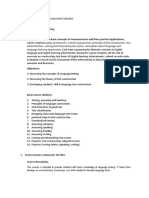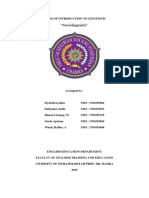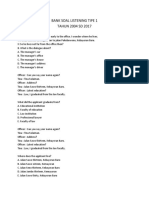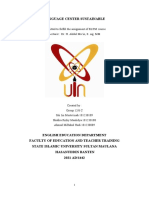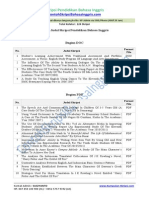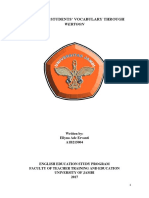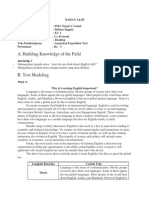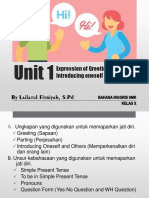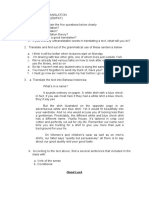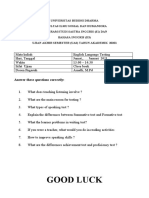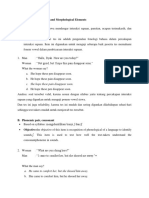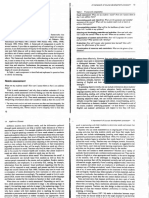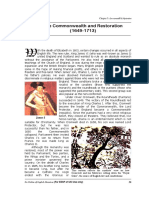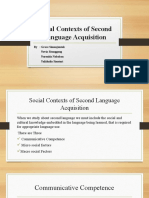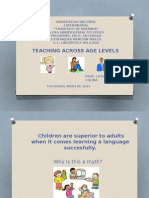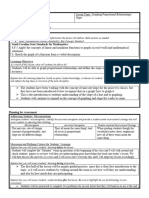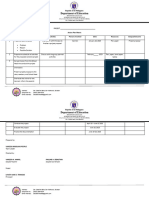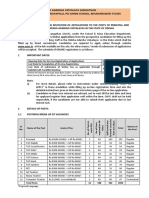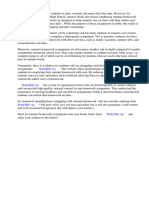Teaching Across Age and Proficiency Levels
Uploaded by
Liliana MelgarejoTeaching Across Age and Proficiency Levels
Uploaded by
Liliana Melgarejoby Liliana Melgarejo
TEACHING ACROSS
AGE LEVELS
Teachers have to take into account the learner variable of age, the
learner variable of language proficiency and others For choice
techniques, lesson organization and supporting materials.
1
TEACHING CHILDREN
Intellectual development language
Children are centered on the here and now because they are in a stage called
1 concrete operations, teachers have that remember their limitations. Teachers have
to explain grammar of different forms but not to say for example: today we will talk
about the present progressive. In childrens some difficult concepts require more
Up to the repetition. Teachers have to avoid the rules that start with abstract terms.
age of Attention span
Children have different attention spans than adults but it means that they have short
about 11 2
attention for materials boring, useless or difficult materials. The teacher's job is to
make the material interesting, fun and wake up the curiosity. A lesson needs a variety
of activities that should be designed to capture their interest. For that a teacher needs
to be animated, enthusiastic and with a sense of humor.
Sensory input
Children need to have all five senses stimulated because of that, activities should
3
focus on that they need. Teachers need to do physical activities like role-play, projects
like science project, job with sensory like touch plants and fruits, and pay attention to
nonverbal language.
Affective factors
4
Children are extremely sensitive, they are more fragile than adults. A negative
interpretation of communication can provoqued potential barriers to learning.
Authentic meaningful material.
5 Children are focused on how they can use that new language in the here and now, for
this the new language have that be authentic. The children need to establish a context
and too, they needs a whole language for will see the important connections.
2 TEACHING TEENAGERS
Intellectual development language
12 TO 18
1 Because of the changes of the teen, the intellect may be suffer. Intellectual capacity of
teen adds abstract operational thoughts. Some sophisticated intellectual processing
and posible complex problems can be solved with logical thinking.
AGE
Attention span
2 The attention span of teen are lengthening as a result of intellectual maturation but
those potential attention spans can easily be shortened.
It is an age of transition,
confusion, self-consciousness
growth and changing bodies
Sensory input
3 Varieties of sensory input are still important, but the increasing capacities lessen the
and minds; teens are in the
essential nature of all five senses.
change between childhood and
Affective factors
adulthood.
Teens are ultrasensitive because of their changing physical and emotional, they need
4
that teacher affirm their mental capabilities.
Authentic meaningful material.
5 The teens have the capacity adultlike to make occasional diversions of immediate
communicative contexts to understand a grammar point of vocabulary item. But care
must be taken not to insult them with stilted language or to bore them with
overanalysis.
3 TEACHING ADULTS
Intellectual development language
Adults are more able to handle abstract rules and concepts.
THE LEVEL OF
1
But teachers have to use more real-life language than abstract.
ADULTS OF SHYNESS
CAN BE EQUAL TO
THAT OF CHILDREN, Attention span
BUT ADULTS HAVE 2 Adults have longer attention spans although the material may
SUPERIOR COGNITIVE not be interesting to them. The role of keeping the activities
ABILITIES THAT CAN short and sweet applies also to adult-age teaching.
BE MORE
SUCCESSFUL IN THE Sensory input
CLASSROOM. 3 Sensory input need not always be as varied with adults.
Affective factors
4 Adults have a minimum of self-confidence, but teachers should
never underestimate the emotional factors that may be
attendant to their second language learning.
Authentic meaningful material.
5 Adults, with their more developed abstract thinking ability,
are better able to understand a context-reduced segment of
language.
TEACHING ACROSS
PROFICIENCY
LEVELS
It is a guideline that recognized proficiency standard in language teaching circles.
The guidelines offer a practical description of speaking, listening, reading and
writing proficiency at numerous levels. Normally it use three levels: beginning,
intermediate and advanced.
1
TEACHING BEGINNING LEVELS
Cognitive learning process
In the first days of language learning, students are in a controlled mode. Teachers have to use
1
repetitions and students speak with a limited number of words, phrases and sentences. Teachers
can introduce the student to use practical language like: what’s your name?
Role of teacher
2
The beginning level classes virtually all the time will be teacher-controlled. Teacher have to use a
modicum of student-centered work , he can use pair work and group work.
Teacher talk
3
The role of the teacher in the class is crucial, all ears and eyes are focuses on he. The english of the
teacher needs to be clearly articulated, he has to slow the speech for easier student
comprehension naturally form, not so slow. Teachers have than use simple vocabulary and
structures according to the level of students.
Fluency and accuracy
4 The fluency in this level is important and it is composed by short segments. The fluency should
center on the particular grammatical, phonological or discourse elements. Teachers have to
correct some selected grammatical and phonological errors so that students don’t assume the
error like a reality.
Techniques
5
Teachers have to use short and simple techniques, a variety of techniques are important at that
stage because of limited language capacity. Repetition, group and pair activities and questions
dominate at this level.
2
TEACHING INTERMEDIATE LEVELS
Cognitive learning process
Students increase the use of phrases, sentences, structures and conversational rules forcing the
mental processes to automate. their capacity is too small to contain all the information they need.
1
Role of teacher
In the intermediate level teacher can design cooperative activities, students should be
2
encouraged to ask questions, to make comments, and negotiate certain options. In this level more
student-student interaction can now take place in pairs, small groups and whole-class activities.
Teacher talk
3
Most of oral production of teachers can be sustained at a natural pace, as long as their
articulation is clear. Teacher talk should not occupy the major proportion of a class because
students have to have the opportunity to talk. The students have to use less the native language
and only for the situations that it may need
Fluency and accuracy
4
Teachers have than be on the lookout to the different types of students and prepared to offer
individualized attention to each. A Big part of his task is to maintain the flow of the students with
just enough attention to error to keep them growing.
Techniques
5
Because of the increasing language capacities of the students, techniques can increase in
complexity. Teachers can use interactive techniques like chain stories, surveys and polls, paired
interviews, group problem solving, role plays, storytelling and many others.
3
TEACHING ADVANCED LEVELS
Cognitive learning process
1
Students can realize the full processing of the language. They can use the formal structures of
language and doing interpretation and negotiation of meaningful to the conveying of thoughts
and feelings in interactive communication. Some aspects of language need minor corrections and
some attention to selected aspects.
Role of teacher
2 The job of the teacher may appear easier with advanced students, he can sit back and let their
questions with self-generated curiosity take over. The role of the teacher can create effective
learning opportunities even with that advanced level.
Teacher talk
3
The teacher has to produce situations for students to have ample opportunities to produce
language with the type of activity. The role of the teacher has to be the provider of feedback. It
would be the ultimate opportunity for some students to be corrected.
Fluency and accuracy
4
Most if not all of the students are fluent, they are not longer thinking about every word or
structure. The errors are relatively rare, and occasionally it will be corrected.
Techniques
5
Techniques in this level can be of sociolinguistic and pragmatic competences. Students have
specific purposes for which they are planning to use english, the teacher has to focus on those
purposes. Typical activities include: group debates and argumentation, complex role plays,
scanning and skimming reading material, determining and questioning the author's intent, and
writing essays and critiques.
You might also like
- Summary and Review of Kreidler's "Sentences As Arguments", In: Introducing English SemanticsNo ratings yetSummary and Review of Kreidler's "Sentences As Arguments", In: Introducing English Semantics3 pages
- The Collection of Language Assessment IndicatorsNo ratings yetThe Collection of Language Assessment Indicators16 pages
- The Use of Speaking Pal Application in Teaching EFL Students in Developing Speaking Skills100% (2)The Use of Speaking Pal Application in Teaching EFL Students in Developing Speaking Skills8 pages
- Skript Bank Soal Listening Tipe 1 2004 SD 2017100% (1)Skript Bank Soal Listening Tipe 1 2004 SD 201718 pages
- Soal UAP Dictation Gasal 2122 - Non RegulerNo ratings yetSoal UAP Dictation Gasal 2122 - Non Reguler3 pages
- Pendidikan Bahasa Inggris Tentang Kumpulan Skripsi Pendidikan Bahasa InggrisNo ratings yetPendidikan Bahasa Inggris Tentang Kumpulan Skripsi Pendidikan Bahasa Inggris14 pages
- Makalah Communicative Language Teaching: Dosen Pembimbing: Yusrah., M.PDNo ratings yetMakalah Communicative Language Teaching: Dosen Pembimbing: Yusrah., M.PD4 pages
- LESSON PLAN Reading Hortatory ExpositionNo ratings yetLESSON PLAN Reading Hortatory Exposition4 pages
- Judul Skripsi Pendidikan Bahasa Inggris (Bhs Inggris) : Sumarni)No ratings yetJudul Skripsi Pendidikan Bahasa Inggris (Bhs Inggris) : Sumarni)7 pages
- UTS Psycolinguistic (Febry Rotama Silaban)No ratings yetUTS Psycolinguistic (Febry Rotama Silaban)4 pages
- Unit 1 Introducing Oneself and Others Part 1No ratings yetUnit 1 Introducing Oneself and Others Part 118 pages
- Rps MK Applied Linguistics Baru 19 Semp 2016-1No ratings yetRps MK Applied Linguistics Baru 19 Semp 2016-114 pages
- Soal Uas English Language Testing (Jan 2021)No ratings yetSoal Uas English Language Testing (Jan 2021)1 page
- Contoh Judul Skripsi Tentang English Speaking0% (1)Contoh Judul Skripsi Tentang English Speaking2 pages
- A Word and Its Part Roots, Affixes, and Their Shapes Adriansyah75% (4)A Word and Its Part Roots, Affixes, and Their Shapes Adriansyah2 pages
- Recognizing Phonological and Morphological Elements A. Phonemic Pair, VowelsNo ratings yetRecognizing Phonological and Morphological Elements A. Phonemic Pair, Vowels24 pages
- Graves, K. (1996) CH - 2 - A Framework For Curriculum DesignNo ratings yetGraves, K. (1996) CH - 2 - A Framework For Curriculum Design16 pages
- The Commonwealth and Restoration (1649-1713) : James INo ratings yetThe Commonwealth and Restoration (1649-1713) : James I11 pages
- KD 3.17 Lesson Plan KD 3.17: IndicatorsNo ratings yetKD 3.17 Lesson Plan KD 3.17: Indicators21 pages
- Social Contexts of Second Language AcquisitionNo ratings yetSocial Contexts of Second Language Acquisition14 pages
- Item Types and Tasks For Assessing SpeakingNo ratings yetItem Types and Tasks For Assessing Speaking14 pages
- Teaching EFL Across Different Ages and Levels.No ratings yetTeaching EFL Across Different Ages and Levels.1 page
- The Index of Item-Objective Congruence Form For Inspector - Solfege ExercisesNo ratings yetThe Index of Item-Objective Congruence Form For Inspector - Solfege Exercises10 pages
- Thinking About The Future of The United States: Mexicans in Search of Educational OpportunitiesNo ratings yetThinking About The Future of The United States: Mexicans in Search of Educational Opportunities4 pages
- 1-Scoe Lesson Planning Template Fa23 2 1No ratings yet1-Scoe Lesson Planning Template Fa23 2 15 pages
- Sites of Pluralism: Community Politics in the Middle East Firat Oruc (Editor) - Instantly access the complete ebook with just one click100% (1)Sites of Pluralism: Community Politics in the Middle East Firat Oruc (Editor) - Instantly access the complete ebook with just one click62 pages
- Class 12 Englih Flamingo Prose Chapter -1. the Last LessonNo ratings yetClass 12 Englih Flamingo Prose Chapter -1. the Last Lesson35 pages
- Answer Key BS English Admission Test Fall 2024No ratings yetAnswer Key BS English Admission Test Fall 20243 pages
- W Whheerree Ddoo Aallll Tthhee Ssttuuddeennttss Ggoo??: AAM Mppuuss EEW WSSNo ratings yetW Whheerree Ddoo Aallll Tthhee Ssttuuddeennttss Ggoo??: AAM Mppuuss EEW WSS16 pages
- MA Economics-Allahabad University Admission-Details 20230921223302No ratings yetMA Economics-Allahabad University Admission-Details 202309212233026 pages
- Certificate of Community Service: Jonathan BaliliNo ratings yetCertificate of Community Service: Jonathan Balili49 pages
- Skill Based Internal Mobility Playbook 1725029654No ratings yetSkill Based Internal Mobility Playbook 172502965456 pages
- Brian Tomlinson - Ways of Making Your Materials More Effective For Your LearnersNo ratings yetBrian Tomlinson - Ways of Making Your Materials More Effective For Your Learners36 pages





